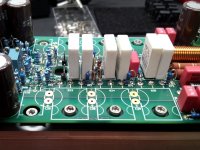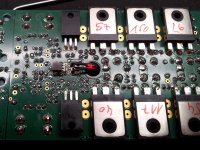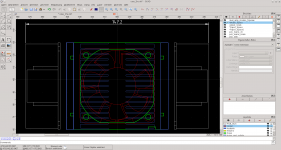Have Fun,
Toni
We see you are having lots of fun!
Very nice and neat build.
Waiting for a video recording.
... ready for take off ...
4 channels finished.
3 channels where working out of the box, the 4th has had 1st CCS LED reversed - took me 15 minutes to repair... 🙂
THD quick test shows that all 4 channels have nearly same low values.🙂
Nice bulid. My only observation, is that You can reduce the noise, and increase the airflow if You keep some distance between the fan and the heatsink. Generally 5-10mm is enough.
Sajti
Nice bulid. My only observation, is that You can reduce the noise, and increase the airflow if You keep some distance between the fan and the heatsink. Generally 5-10mm is enough.
Sajti
Dear Sajti,
THX! Maybe you are right for the most standard fan's...
This is a flow optimized ultra low noise fan (8.2 dbA). I have done some noise checks before designing the fan holder. The current distance fan to heatsink is about 3 mm.
Attached a cad front view of the fan/heatsink unit.
BR, Toni
Attachments
Toni
I aspire to being able to understand completely your 200W/8R circuit (and the Tian probe technique you've used in LTspice). I am re-reading Cordell and Self with your circuit in hand. I very much want to build this amp but only when I understand it completely.
I'm aware, however, that there's a lot more to your amp than the IPS/VAS and OPS boards (and supplies - these I "get" already having spent more time with supplies). Have you posted anywhere your circuits for protection, in-rush management etc? If so, I wonder if you could update the first post with links? Also, I realise that I'd need match transistors and I see you've designed a "jig" to do this more efficiently. Again, links in the first post to how you did this would be fantastic.
I know you have a lot of work going on with your current build but if you ever get the opportunity to help with the above it would be very much appreciated by people like me.
ATB
Steve
I aspire to being able to understand completely your 200W/8R circuit (and the Tian probe technique you've used in LTspice). I am re-reading Cordell and Self with your circuit in hand. I very much want to build this amp but only when I understand it completely.
I'm aware, however, that there's a lot more to your amp than the IPS/VAS and OPS boards (and supplies - these I "get" already having spent more time with supplies). Have you posted anywhere your circuits for protection, in-rush management etc? If so, I wonder if you could update the first post with links? Also, I realise that I'd need match transistors and I see you've designed a "jig" to do this more efficiently. Again, links in the first post to how you did this would be fantastic.
I know you have a lot of work going on with your current build but if you ever get the opportunity to help with the above it would be very much appreciated by people like me.
ATB
Steve
Dear Steve,
of course I will help you building the SA2014 200W. Send an Email to "sa2014 at aws-it.at'' if you need some special parts.
BR, Toni
of course I will help you building the SA2014 200W. Send an Email to "sa2014 at aws-it.at'' if you need some special parts.
BR, Toni
Toni
...
Have you posted anywhere your circuits for protection, in-rush management etc? If so, I wonder if you could update the first post with links? Also, I realise that I'd need match transistors and I see you've designed a "jig" to do this more efficiently. Again, links in the first post to how you did this would be fantastic.
...
Inrush control, DC speaker control, temperature control, remote controlled power on/off => house keeping circuit has been published here:
http://www.diyaudio.com/forums/chip...ing-only-bridged-8-ohms-only.html#post3220966
Needs my homebrew pic micro software to run.
Matching transistors would be easy if you own 2 DC voltmeters or own a specialised tester like Peak Atlas DCA55 or DCA75pro.
BR, Toni
Many, many thanks Toni!
I still have a lot of reading/studying to do before I think about my own construction. At the moment I have too many little questions regarding the amp circuit - I need to work through as many of these as I can by myself. 🙂 But I think your build is a very good one to focus on while reading/learning and to ultimately build.
I've finished my 5A+ regulator and ATX power control build and am currently doing a little headphone amp build. In between, I read/re-read Cordell and Self with your circuit in-hand.
(PS I assume you are using the same in-rush circuit but for just the one transformer in the SA2014 build. My ATX PSU build required an in-rush circuit but not having access to PIC controller skills I used a timing circuit based on the boards sold in the DIYaudio store. Works fine, but of course not as 'neat' as one with timing managed by software.)
I still have a lot of reading/studying to do before I think about my own construction. At the moment I have too many little questions regarding the amp circuit - I need to work through as many of these as I can by myself. 🙂 But I think your build is a very good one to focus on while reading/learning and to ultimately build.
I've finished my 5A+ regulator and ATX power control build and am currently doing a little headphone amp build. In between, I read/re-read Cordell and Self with your circuit in-hand.
(PS I assume you are using the same in-rush circuit but for just the one transformer in the SA2014 build. My ATX PSU build required an in-rush circuit but not having access to PIC controller skills I used a timing circuit based on the boards sold in the DIYaudio store. Works fine, but of course not as 'neat' as one with timing managed by software.)
...
(PS I assume you are using the same in-rush circuit but for just the one transformer in the SA2014 build.
...
Yes - the same circuits are used if you compare the pictures of both amplifiers. BTW: the housekeeping circuit supports 2 transformers to be able to build a dual mono amplifier.
Send an email to sa2014 at aws-it.at if you need the pic micro + software.
BR, Toni
BTW Toni it may make sense to update the first post to refer to the PSU with the snubber network in post #1005 rather than the one in #993.
Last edited:
BTW Toni it may make sense to update the first post to refer to the PSU with the snubber network in post #1005 rather than the one in #993.
Dear SGK,
yes that makes sense. Done!
Maybe I will rework the power supply pcb:
- add alternative lytics pin layout
- add alternative diode pin layout
Last edited:
Just found a 2nd source for the now obsolete Toshiba 2SC4793, 2SA1837:
Medium Power-Driver | Profusion Audio Design
Has anyone experience using this Unitronic variants?
BR, Toni
Medium Power-Driver | Profusion Audio Design
Has anyone experience using this Unitronic variants?
BR, Toni
I was warned against that brand being inferior, but I won't dismiss it totally until I see tests.
Thx!
I have tons of original Toshiba's 2SC4793/2SA1837 but I'm thinking about to give the Unisonics a try ...
Merry Christmas and a happy new year to all DIY fans!
BR, Toni
I have tons of original Toshiba's 2SC4793/2SA1837 but I'm thinking about to give the Unisonics a try ...
Merry Christmas and a happy new year to all DIY fans!
BR, Toni
Thx!
I have tons of original Toshiba's 2SC4793/2SA1837 but I'm thinking about to give the Unisonics a try ...
Merry Christmas and a happy new year to all DIY fans!
BR, Toni
I gave a try to Unisonics, but I had a bit bad experience. The Hfe was less consistent. So I cleaned up the mouser for the originals. Now I have about 300npn, and 300pnp.
Sad, that we have to say goodbye for the best bjts 🙁
Sajti
SA2015: BOM/using lateral mosfets EXC10N20 EXC10P20
Has anybody practical experience how small the oscillation avoidance gate resistors can be when using the Exicon lateral mosfet types as OPS transistors?
EXC10N20, EXC10P20
and/or
ECW20N20, ECW20P20
TIA, Toni
Has anybody practical experience how small the oscillation avoidance gate resistors can be when using the Exicon lateral mosfet types as OPS transistors?
EXC10N20, EXC10P20
and/or
ECW20N20, ECW20P20
TIA, Toni
Ian Hegglun's cube-law amp uses 470R gate stoppers for the 20X20.
The amount needed probably depends a lot on what is driving the FETs, so you might be fine with more or less.
The amount needed probably depends a lot on what is driving the FETs, so you might be fine with more or less.
Thx!
I have tons of original Toshiba's 2SC4793/2SA1837 but I'm thinking about to give the Unisonics a try ...
Merry Christmas and a happy new year to all DIY fans!
BR, Toni
I was warned away from Unisonic transistors when they were being sold at Profusion by homemodder who said they were slow and inferior. This was for the D669/B649 pair but I imagine it applies to many of the others.
But, it would be nice to see some actual comparisons.
Try the Sanken 2SC4883A/A1859A which can still be gotten from Digikey. My models cover quasi-saturation:
.MODEL 2SC4883A_kq npn (Bf=140 Ikf=100 Is=600f Vaf=300
+ Rb=1.7 Re=105m RC=0 Rco=6 Ibc=150f Vo=30 Gamma=250n
+ Cje=1.2n Cjc=72p Tf=875p Vtf=1.2 Itf=1 Qco=8p
+ Nk=1.2 Br=2 Var=22.9 Ikr=36 TR=85n
+ Xtb=0.34 Xtf=1.36
+ Vceo=180 Icrating=2A mfg=Sanken)
.MODEL 2SA1859A_kq pnp (Bf=162 IKF=10 Is=500f Vaf=350
+ Rb=0 Re=0 Rc=90m Rco=3.25 Ibc=150f Vo=120 Gamma=22n
+ Cje=1.5n Cjc=72p Tf=1.9n Vtf=1.9 Itf=1 Qco=8p
+ Br=2 Ikr=10 Var=23 Tr=188.8n
+ Xtb=0.138 Xtf=5
+ Vceo=180 Icrating=2A mfg=Sanken)
.MODEL 2SC4883A_kq npn (Bf=140 Ikf=100 Is=600f Vaf=300
+ Rb=1.7 Re=105m RC=0 Rco=6 Ibc=150f Vo=30 Gamma=250n
+ Cje=1.2n Cjc=72p Tf=875p Vtf=1.2 Itf=1 Qco=8p
+ Nk=1.2 Br=2 Var=22.9 Ikr=36 TR=85n
+ Xtb=0.34 Xtf=1.36
+ Vceo=180 Icrating=2A mfg=Sanken)
.MODEL 2SA1859A_kq pnp (Bf=162 IKF=10 Is=500f Vaf=350
+ Rb=0 Re=0 Rc=90m Rco=3.25 Ibc=150f Vo=120 Gamma=22n
+ Cje=1.5n Cjc=72p Tf=1.9n Vtf=1.9 Itf=1 Qco=8p
+ Br=2 Ikr=10 Var=23 Tr=188.8n
+ Xtb=0.138 Xtf=5
+ Vceo=180 Icrating=2A mfg=Sanken)
- Home
- Amplifiers
- Solid State
- 2stageEF high performance class AB power amp / 200W8R / 400W4R


